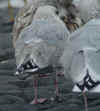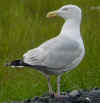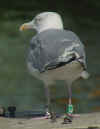 Herring
Gull- Zilvermeeuw (L. argentatus argenteus)
Herring
Gull- Zilvermeeuw (L. argentatus argenteus)
(last update: 04 december 2003)
Herring Gull argentatus
Herring Gull argenteus
Herring Gull smithsonianus
Great
Black-backed Gull marinus
Lesser B-b Gull
graellsii / intermedius
Lesser B-b Gull
fuscus
Yellow-legged
Gull michahellis
Yellow-legged
Gull atlantis
Caspian Gull cachinnans
Armenian Gull
armenicus
Baraba Gull barabensis
Heuglini's Gull
heuglini
Vega Gull
vegae
Mongolian Gull
mongolicus
Slaty-backed
Gull
schistisagus
.
Black-headed
Gull ridibundus
Grey-headed
Gull cirrocephalus
Brown-headed Gull
brunnicephalus
Bonaparte's
Gull philadelphia
Little Gull minutus
Mediterranean
Gull melanocephalus
Relict Gull relictus
Audouin's Gull audouinii
Slender-billed
Gull genei
Common / Mew
Gull canus
Ring-billed
Gull delawarensis
Franklin's Gull
pipixcan
Laughing Gull atricilla
Kittiwake Rissa
tridactyla
Ivory Gull Pagophila
eburnea
Ross's Gull Rodosthetia
rosea
Sabine's
Gull sabini
Great
Black-headed Gull ichtyaetus
Sooty Gull hemprichii
White-eyed Gull leucophthalmus
Glaucous
Gull hyperboreus
Iceland Gull glaucoides
Thayer's Gull thayeri
Kumlien's
Gull kumlieni
.
Mystery Gulls
Skua's Catharacta
/ Stercorarius
Terns Sterna
Other
Birds & Mammals
.
Home
Links
to Gullsites
Gull taxa
Gull Topography
Grey & Colour Charts
Locations in NW Europe
Summaries of Articles
About ORG
@
1CY
ARGENTEUS
In juvenile plumage, the head and
under-parts are streaked grey-brown, rather pale on forehead and throat
and with dark ear-coverts. The mantle and scapulars are brown based with
buffish-yellowish notches in the fringe when the feathers are fresh. The notched
pattern is repeated on the lesser, lower lesser and median coverts. The
greater coverts show a 'piano-key' pattern; on the outer greater coverts
as well. The tertials have an obvious pale fringe and transversal bar. The
secondaries, primaries and primary coverts are dark, but the inner
primaries show an obvious pale window, prominent from below and above. The
under-wing is rather uniform grey-brown patterned. The
tail has a broad sub-terminal band and isolated dark bars on the basal
half.
The iris is dark brown, the bill is blackish, sometimes with a paler base,
and the legs are flesh-pink.
| comparison of the three taxa of Herring Gull: juveniles from August. | ||
 juvenile argenteus |
 juvenile argentatus |
juvenile smithsonianus |
The partial autumn moult (moult into so-called "first winter" plumage) includes the body and head feathers. This moult starts as soon as the nest is abandoned (late June) and continues until January. In general, the head turns paler on throat and forehead. The breast turns paler as well. The feathers on belly and vent are still juvenile in most 1cy argenteus by November. The mantle and upper scapulars are moulted to second generation feathers, showing an anchor pattern and a dark base. The lowest row of scapulars are still juvenile by March in most 2cy birds (contra e.g. michahellis). The juvenile wing-coverts, rectrices and remiges start to bleach and show wear in the fringes.
| comparison of the three taxa of Herring Gull: 2cy from January. | ||
 2cy argenteus |
 2cy argentatus |
2cy smithsonianus |
2CY ARGENTEUS
The next moult is a partial moult of head
and body in spring. It starts in January and ends by May, leaving birds in so-called "first
summer" plumage. The head and under-parts resemble the pattern in 1cy birds,
although the head and breast turn much paler by June. The lower scapulars may still be
moulted in this period, showing a buffish tone and a neat pale fringe. The
adjacent juvenile rear lowest scapulars are very worn by March.
| comparison of the three taxa of Herring Gull: 2cy from May. | ||
 2cy argenteus |
2cy argentatus
|
2cy smithsonianus
|
From May onwards, a complete
moult will bring birds in so-called "second
winter" plumage by October. The head will show neat fine
streaking by October; the under-parts and rump turns pale, mottled brown. The scapulars and mantle
moult to third generation feathers, especially in the mantle and upper
scapulars. The pattern is more or less similar to the anchor pattern of
the second generation feathers, but can be recognized by the warm buffish
tone and neat white fringe as long as the feathers are fresh. Only a few new scapulars
may be
pale grey adult-like feathers. By October, the upper scapulars are
replaced and argenteus is actively moulting the lower scapulars, with still some
old second generation rear lower scapulars.
From late April, the wing-coverts and the very abraded tertials will be
replaced, starting with the median coverts, upper tertials and
innermost greater coverts. The fresh feathers are buffish-based with
an obvious barred pattern. By July, the warm tones of the first moulted
feathers are faded to plain white, leaving a contrasting barred pattern on
the wing-coverts. The last
coverts to be moulted are the central greater coverts, replaced by
mid-August; the new greater coverts may show a vermiculated, densely
barred pattern.
From early April, the inner primaries are shed and new second generation
primaries grown in. The last juvenile primary (P10) will be shed by the
first week of August. The majority of argenteus complete the primary
moult by the first week of October, with a new second generation P10 fully
grown. The new primaries are
dark with a tiny pale tip on the fresh flight-feathers. Again, the four inner primaries
show an extensive pale window, as both inner and outer-web are pale
greyish white-brown, contrasting with the outer-wing. A pale inner-web can still be found in P7.
The under-wing is largely pale with pale brown barring.
The second generation tail-feathers show a clear-cut blackish tail-band
with only isolated blackish markings on the white basal half. The rump is largely white.
The iris is pale brown. The bill shows a pale pinkish base with a dark
tip. The legs are flesh-pink.
| comparison of the three taxa of Herring Gull: 2cy from September. | ||
 2cy argenteus |
2cy argentatus |
2cy smithsonianus |
According to Grant ("Gulls, a guide to identification"), the next moult in argenteus is a partial moult in spring (in 3cy birds). However, continental argenteus has a partial moult in autumn in second calendar year as well (click here for a clear example). The moult sequence in autumn in the scapulars is not completely clear, but from September onwards, 2cy argenteus may moult the upper tertials, innermost greater coverts and various amount of median coverts and sometimes lower lesser coverts to third generation feathers (some of them more adult-like in pattern). This moult to third generation wing-coverts may overlap with the replacement to second generation feathers (the last replaced coverts: upper lesser coverts and the seventh and eighth greater coverts).
| comparison of the three taxa of Herring Gull: 3cy from January. | ||
 3cy argenteus |
 3cy argentatus |
3cy smithsonianus |
3CY ARGENTEUS
The next moult is a partial moult in spring. It starts in
January and is completed by April, leaving birds in so-called "second
summer" plumage. The head turns white, especially on throat,
breast and belly. By April, the scapulars and mantle will show many
adult-like grey feathers, creating a contrasting saddle, as most of the
wing-coverts are still barred. The wing-coverts start to fade and the
fringes wear off. The iris and base of the bill turn pale yellow, although
some individuals show a warm amber iris. The bill shows some red on the
gonydeal angle and still an obvious dark bill-band.
| comparison of the three taxa of Herring Gull: 3cy from May. | ||
 3cy argenteus |
3cy argentatus |
3cy smithsonianus |
From June to October, a complete
moult will bring birds in so-called "third winter" plumage.
In summer, the head is still largely white, but after the complete moult is
finished, the head shows extensive 'winter streaking', mottled brown contrasting with the white
breast as in an
executioner's hood. The
scapulars and mantle are pale adult-like grey, although some lower
scapulars may show a pale brown hue.
By mid-summer the old second
generation wing-coverts are bleached, almost white, but by July the new
third generation plain grey wing-coverts are moulted in, starting with the
outermost median coverts. When inner greater coverts and median coverts
were included in the partial autumn moult in 2cy, these feathers are left
out of the moult sequence in the early moult-stage. By the end of the
complete moult (October), all wing-coverts have been replaced, most to
plain grey feathers. Immature patterns can often be found in the lower
tertials, greater coverts and outer lesser coverts (the carpal edge).
During the summer, the primaries are moulted to third generation. The first inner primaries
are dropped by late May and the outer primary P10 is dropped by late
August. The primary moult is completed by late-October, when the new outer
primary P10 is fully grown. The third generation primaries are clearly
adult-like, with the inner primaries P1-P4 plain grey and with a white tip.
The outer-wing shows a clear black triangle, extending on the greater primary
coverts. From P5 outwards, the primaries show a black sub-terminal band.
The primary tips are obvious in the inner primaries, but only poor
developed on P9 and P10. P10 has a small mirror (lacking in some birds).
The tail-feathers are white, with clear immature black markings. The iris
turns paler in summer (July).
| comparison of the three taxa of Herring Gull: 3cy from September. | ||
 3cy argenteus |
3cy argentatus |
3cy smithsonianus |
4CY ARGENTEUS
The next moult is a partial moult of head and body in spring. It starts in
January and is completed by April, leaving birds in so-called "third
summer" plumage. By April, the head and under-parts are
white. The tail-feathers, wing-coverts and primaries are not replaced,
therefore most birds strongly resemble "third winter"
birds,
although the white primary tips wear away and dark patches start to
bleach. The iris is yellow, the orbital ring yellowish-orange and the bill
predominantly yellow with a red gonydeal spot and limited black markings
along the culmen.
| comparison of the three taxa of Herring Gull: 4cy from January-February. | ||
 4cy argenteus |
 4cy argentatus |
4cy smithsonianus |
From June to October, a complete
moult will bring birds in so-called "adult winter" plumage.
As long as the old outer third generation primaries are visible (until
August), ageing as 4cy argenteus is rather straightforward. From
November onwards, 4cy argenteus much resembles adult birds, except
that the bare parts still show immature features: the black bill-band
is obvious, extending over both upper and lower mandible. On average, this
plumage develops a more pronounced winter 'hood' than in full adults: dense streaking on head,
especially around the eye and in the hind-neck. The upper-parts,
wing-coverts and tertials appear adult-like grey from 4cy October onwards.
The fourth generation tail-feathers are plain white.
The new fourth generation primaries are similar to the adult primaries,
although the primary tips may appear slightly smaller, but otherwise similar in
pattern: grey inner-wing and black outer-wing. Both P9 and P10 show
a mirror. P5 shows small black
sub-terminal markings, concentrated on the outer-web as a clear-cut black
angular spot and rarely extending on the inner-web as a diffuse streak.
There may be some black on P4 as well. Adult
argenteus show a different pattern in the outer primaries, compared
to northern argentatus.
In argentatus, especially from northern Scandinavia, the black marking on P5
is very limited and diffuse or this is sub-terminal markings are completely
lacking on P5.
Argenteus has more black in the outer primaries,
including a black band on the top of p10 in most birds, dividing the tip
from the mirror. If the black sub-terminal band on P10 is broken, the
outer-web of p10 still shows black marking. Argentatus normally
lacks sub-terminal markings on the outer-web of P10.
The scapular coverts are plain grey, lacking white crescents. The tertials
show obvious white tips. The iris is yellow. The bill is yellow with a red
gonydeal spot confined to the lower mandible. The orbital ring is
yellow-orange or orange-red. The legs are flesh-pink.
| comparison of the three taxa of Herring Gull: 4cy from August. | ||
4cy argenteus |
 4cy argentatus |
4cy smithsonianus |
ADULT ARGENTEUS
The next moult is a partial moult of body and head in spring. It starts in
January (when adults in the Netherlands may already return to the
colonies) and is completed by April, leaving birds in so-called "adult
summer" plumage. The head is clean white and the white primary tips
are slightly worn and the dark
patches bleached. Otherwise, this plumage much resembles the "adult
winter" plumage. The bare parts are more saturated.
| comparison of the three taxa of Herring Gull: adult from January. | ||
 adult argenteus |
 adult argentatus |
adult smithsonianus |
Measurements in mmís wing: 375-447, tail: 152-189, bill: 45-58, tarsus: 55-70; n = 18 (origin of taxon unknown, Dwight, 1925).
ARGENTATUS & ARGENTEUS Herring Gulls are treated together. Click the thumbnails to go the monthly sections.
 August
1cy.
August
1cy.(argenteus), August 18 2001, Maasvlakte, the Netherlands (51.58N-04.02E).
 September 1cy.
September 1cy.A1FV (argenteus), September 22 2002, Boulogne/Mer, NW France (50.43N-01.37E).
 October
1cy.
October
1cy.H-12?4 (argenteus), October 05 2002, Boulogne/Mer, France (50.43N-01.37E).
 November 1cy.
November 1cy.HNJ (argenteus), November 07 1999, Westkapelle, the Netherlands (51.33N-03.25E).
 December
1cy.
December
1cy.VXV8 (argentatus), December 23 2002, Amsterdam, the Netherlands (52.21N-04.52E).
 January
2cy.
January
2cy.H-117045 (argenteus), January 04 2002, Boulogne/Mer, France (50.42N,1.34E).
 February 2cy.
February 2cy.BZAM (argenteus), February 15 2001, Oostende, Belgium (51.13N-02.55E).
 March
2cy.
March
2cy. VA33 (argentatus), Denmark and Finland. Pictures from Denmark by Frank Abrahamson.
 April 2cy.
April 2cy.5.365.836 (argenteus), April 19 2002, Boulogne/Mer, France (50.42N,1.34E).
 May 2cy.
May 2cy.H-117661 (argenteus), May 16 2002, Boulogne/Mer, France (50.42N,1.34E).
 June
2cy.
June
2cy.DA 216321 (argenteus), June 13 2002, Boulogne/Mer, France (50.42N,1.34E).
 July
2cy.
July
2cy.DA 212950 (argenteus), July 10 & 11 2002, Boulogne/Mer, France (50.42N,1.34E).
 August
2cy.
August
2cy.C527R (argentatus), August 11 2002, Tampere, Finland (61.31N,23.43E).
 September 2cy.
September 2cy.5.358.143 (argenteus), September 24 2002, IJmuiden, the Netherlands (52.27N-04.33E).
 October 2cy.
October 2cy.H-113894 (argenteus), October 03-04 2002, Boulogne-sur-Mer, France (50.43N-01.37E).
 November 2cy.
November 2cy.5.365.084 (argenteus), November 16 2002, Westkapelle, the Netherlands (51.33N-03.25E).
(argenteus), December 21 2001, Brouwersdam, the Netherlands (51.45N-03.51E).
 January 3cy.
January 3cy.H-108929 (argenteus), January 05 2002, Boulogne/Mer, France (50.42N,1.34E).
 February 3cy.
February 3cy.(argenteus), February 07 2002, IJmuiden, the Netherlands (52.27N-04.33E).
 April
3cy.
April
3cy.(argenteus), April 12 2001, IJmuiden, the Netherlands (52.27N-04.33E).
 May
3cy.
May
3cy.KCU (argenteus), May 23 2002, Maasvlakte, the Netherlands (51.59N,04.02E).
 June 3cy.
June 3cy.H-105381 (argenteus), June 13 2002, Boulogne/Mer, France (50.42N,1.34E).
 July
3cy.
July
3cy. H-xxxxxx (argenteus), July 11 2002, Boulogne/Mer, France (50.42N,1.34E).
 August
3cy.
August
3cy.C525K (argentatus), August 11 2002, Tampere, Finland (61.31N,23.43E).
 September 3cy.
September 3cy.5.335.124 (argenteus), September 24 2002, Scheveningen, the Netherlands.
 October
3cy.
October
3cy.H-107901 (argenteus), October 18 2002, Westkapelle, the Netherlands (51.33N-03.25E).
 November
3cy.
November
3cy.H-107901 (argenteus), November 16 2002, Westkapelle, the Netherlands (51.33N-03.25E).
 December
3cy.
December
3cy.(argentatus), December 21 2001, Brouwersdam, the Netherlands (51.457N-03.51E).
 January
sub-adult.
January
sub-adult.HT-195.171 (argentatus), January 04 2002, Boulogne/Mer, France (50.42N,1.34E).
 February
sub-adult.
February
sub-adult.5.325.398 (argenteus), February 04 2002, IJmuiden, the Netherlands (52.27N-04.33E).
 April
sub-adult.
April
sub-adult.(argentatus), April 19 2002, Boulogne/Mer, France (50.42N,1.34E).
 May
sub-adult.
May
sub-adult.(argenteus), May 31 2002, Maasvlakte, the Netherlands (51.59N,04.02E).
 August
sub-adult.
August
sub-adult.C154A (argentatus), August 12 2002, Tampere, Finland (61.31N,23.43E).
 October
sub-adult.
October
sub-adult.5.325.398 (argenteus), October 22 2002, IJmuiden, the Netherlands (52.27N-04.33E).
 November
sub-adult.
November
sub-adult.BHAK (argenteus), November 16 2002, Westkapelle, the Netherlands (51.33N-03.25E).
 January
adult.
January
adult.X994 (argentatus), January 04 2002, Boulogne/Mer, France (50.43N-01.37E).
 February adult.
February adult.5.360.719 (argenteus), February 04 2002, IJmuiden, the Netherlands (52.27N-04.33E).
 March adult.
March adult.5.359.457 (argenteus), March 18 2002, Maasvlakte, the Netherlands (51.59N,04.02E).
 April adult.
April adult.5.536.103 (argenteus), April 15 2001, IJmuiden, the Netherlands (52.27N-04.33E).
 May
adult.
May
adult.(argenteus), May 13 2002, Dintelhaven, Maasvlakte, the Netherlands (51.59N,04.02E).
 June adult.
June adult.(argenteus), June 26 2001, Bergen op Zoom, the Netherlands (51.29N-04.17E).
 July
adult.
July
adult.(argenteus), July 14 2001, IJmuiden, the Netherlands (52.27N-04.33E).
 August
adult.
August
adult.CR47 (argentatus), August 08 2002, Tampere, Finland (61.31N,23.43E).
 September adult.
September adult.SA (argenteus), September 24 2002, IJmuiden, the Netherlands (52.27N-04.33E).
 October adult.
October adult.JR9 (argenteus), October 19 2002, Brouwersdam, the Netherlands (51.457N-03.51E).
 November adult.
November adult.H-125585 (argenteus), November 16 2002, Westkapelle, the Netherlands (51.33N-03.25E).
 December
adult.
December
adult.(argentatus), December 21 2001, Brouwersdam, the Netherlands (51.457N-03.51E).